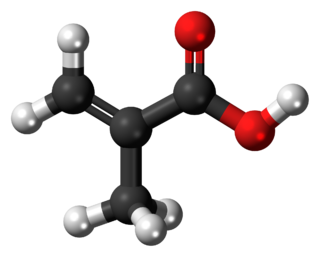Methacrylates are derivatives of methacrylic acid. These derivatives are mainly used to make poly(methyl methacrylate) and related polymers.
Methacrylates are derivatives of methacrylic acid. These derivatives are mainly used to make poly(methyl methacrylate) and related polymers.

Poly(methyl methacrylate) (PMMA) is the synthetic polymer derived from methyl methacrylate. Being an engineering plastics, it is a transparent thermoplastic. PMMA is also known as acrylic, acrylic glass, as well as by the trade names and brands Crylux, Plexiglas, Acrylite, Astariglas, Lucite, Perclax, and Perspex, among several others. This plastic is often used in sheet form as a lightweight or shatter-resistant alternative to glass. It can also be used as a casting resin, in inks and coatings, and for many other purposes.
Acrylic may refer to:
Mixed martial arts (MMA) is a full-contact combat sport.

Acrylates (IUPAC: prop-2-enoates) are the salts, esters, and conjugate bases of acrylic acid. The acrylate ion is the anion CH2=CHCOO−. Often, acrylate refers to esters of acrylic acid, the most common member being methyl acrylate. These acrylates contain vinyl groups. These compounds are of interest because they are bifunctional: the vinyl group is susceptible to polymerization and the carboxylate group carries myriad functionalities. Methacrylates (CH2=C(CH3)CO2R) and cyanoacrylates (CH2=C(CN)CO2R) are usually considered separately even though they share several properties. Acrylate can refer to polyacrylates prepared through the polymerization of the vinyl groups of acrylate monomers.

Ergoline is a chemical compound whose structural skeleton is contained in a variety of alkaloids, referred to as ergoline derivatives or ergoline alkaloids. Ergoline alkaloids, one being ergine, were initially characterized in ergot. Some of these are implicated in the condition ergotism, which can take a convulsive form or a gangrenous form. Even so, many ergoline alkaloids have been found to be clinically useful. Annual world production of ergot alkaloids has been estimated at 5,000–8,000 kg of all ergopeptines and 10,000–15,000 kg of lysergic acid, used primarily in the manufacture of semi-synthetic derivatives.
PMMA may refer to:

Methyl methacrylate (MMA) is an organic compound with the formula CH2=C(CH3)COOCH3. This colorless liquid, the methyl ester of methacrylic acid (MAA), is a monomer produced on a large scale for the production of poly(methyl methacrylate) (PMMA).
A variety of isomers of methyl indole derivatives are known:

Poly(methyl acrylate) (PMA) is a family of organic polymers with the formula (CH2CHCO2CH3)n. It is a synthetic acrylate polymer derived from methyl acrylate monomer. The polymers are colorless. This homopolymer is far less important than copolymers derived from methyl acrylate and other monomers. PMA is softer than polymethyl methacrylate (PMMA), It is tough, leathery, and flexible.

The frontal sinuses are one of the four pairs of paranasal sinuses that are situated behind the brow ridges. Sinuses are mucosa-lined airspaces within the bones of the face and skull. Each opens into the anterior part of the corresponding middle nasal meatus of the nose through the frontonasal duct which traverses the anterior part of the labyrinth of the ethmoid. These structures then open into the semilunar hiatus in the middle meatus.

Methacrylic acid, abbreviated MAA, is an organic compound. This colorless, viscous liquid is a carboxylic acid with an acrid unpleasant odor. It is soluble in warm water and miscible with most organic solvents. Methacrylic acid is produced industrially on a large scale as a precursor to its esters, especially methyl methacrylate (MMA), and to poly(methyl methacrylate) (PMMA).
Acetone cyanohydrin (ACH) is an organic compound used in the production of methyl methacrylate, the monomer of the transparent plastic polymethyl methacrylate (PMMA), also known as acrylic. It liberates hydrogen cyanide easily, so it is used as a source of such. For this reason, this cyanohydrin is also highly toxic.
The molecular formula C5H8O2 may refer to:

Ammonium bisulfate, also known as ammonium hydrogen sulfate, is a white, crystalline solid with the formula (NH4)HSO4. This salt is the product of the half-neutralization of sulfuric acid by ammonia.

Methyl propionate, also known as methyl propanoate, is an organic compound with the molecular formula CH3CH2CO2CH3. It is a colorless liquid with a fruity, rum-like odor.

Europium acetylacetonate is a compound with formula Eu(C5H7O2)3(H2O)2. It is a europium(III) complex with three acetylacetonate and two aquo ligands. The electronic structure of the Eu3+
core gives the complex an unusual charge-transfer band absent in other lanthanide acetylacetonates. The photoluminescent emission lines occur near 465 (blue), 525 (green), and 579 nm (yellow), and are unusually sharp, especially the yellow doublet. Doping a blend of polyacrylate and polycarbonate with europium acetylacetonate enhances photoluminescence over a broad range of ultraviolet wavelengths. EuFOD is a substituted derivative.
Methylacrylate may refer to:
Poly(ethyl methacrylate) (PEMA) is a hydrophobic synthetic acrylate polymer. It has properties similar to the more common PMMA, however it produces less heat during polymerization, has a lower modulus of elasticity and an overall softer texture. It may be vulcanized using lead oxide as a catalyst and it can be softened using ethanol.

Butyl methacrylate is the organic compound with the formula C4H9O2CC(CH3)=CH2. A colorless liquid, it is a common monomer for the preparation of methacrylate polymers. It is typically polymerized under free-radical conditions.

Ethyl methacrylate is the organic compound with the formula C2H5O2CC(CH3)=CH2. A colorless liquid, it is a common monomer for the preparation of acrylate polymers. It is typically polymerized under free-radical conditions.